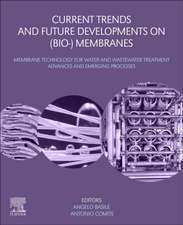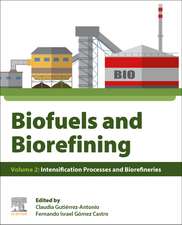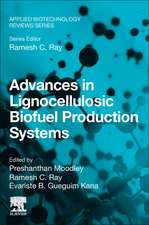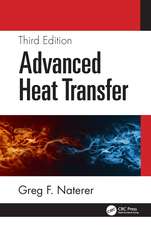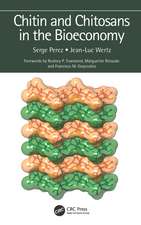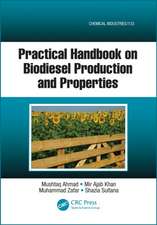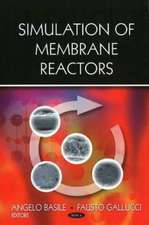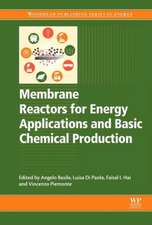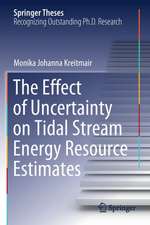Advances in Hydrogen Production, Storage and Distribution: Woodhead Publishing Series in Energy
Editat de Adolfo Iulianelli, Angelo Basileen Limba Engleză Hardback – 7 iul 2014
Part one introduces the fundamentals of hydrogen production, storage, and distribution, including an overview of the development of the necessary infrastructure, an analysis of the potential environmental benefits, and a review of some important hydrogen production technologies in conventional, bio-based, and nuclear power plants. Part two focuses on hydrogen production from renewable resources, and includes chapters outlining the production of hydrogen through water electrolysis, photocatalysis, and bioengineered algae. Finally, part three covers hydrogen production using inorganic membrane reactors, the storage of hydrogen, fuel cell technology, and the potential of hydrogen as a fuel for transportation.
Advances in Hydrogen Production, Storage and Distribution provides a detailed overview of the components and challenges of a hydrogen economy. This book is an invaluable resource for research and development professionals in the energy industry, as well as academics with an interest in this important subject.
- Reviews developments and research in this dynamic area
- Discusses the challenges of creating an infrastructure to store and distribute hydrogen
- Reviews the production of hydrogen using electrolysis and photo-catalytic methods
Din seria Woodhead Publishing Series in Energy
-
 Preț: 853.23 lei
Preț: 853.23 lei - 24%
 Preț: 1209.19 lei
Preț: 1209.19 lei - 24%
 Preț: 1307.96 lei
Preț: 1307.96 lei - 24%
 Preț: 1386.95 lei
Preț: 1386.95 lei - 9%
 Preț: 900.25 lei
Preț: 900.25 lei - 9%
 Preț: 1067.83 lei
Preț: 1067.83 lei - 29%
 Preț: 1071.46 lei
Preț: 1071.46 lei - 9%
 Preț: 950.40 lei
Preț: 950.40 lei - 9%
 Preț: 1011.50 lei
Preț: 1011.50 lei - 29%
 Preț: 1071.13 lei
Preț: 1071.13 lei - 9%
 Preț: 1309.35 lei
Preț: 1309.35 lei - 39%
 Preț: 1047.65 lei
Preț: 1047.65 lei - 9%
 Preț: 949.23 lei
Preț: 949.23 lei - 24%
 Preț: 1688.64 lei
Preț: 1688.64 lei - 9%
 Preț: 1344.70 lei
Preț: 1344.70 lei - 9%
 Preț: 1049.56 lei
Preț: 1049.56 lei - 27%
 Preț: 1937.44 lei
Preț: 1937.44 lei - 23%
 Preț: 1519.01 lei
Preț: 1519.01 lei - 29%
 Preț: 981.24 lei
Preț: 981.24 lei - 9%
 Preț: 1397.24 lei
Preț: 1397.24 lei - 39%
 Preț: 1397.48 lei
Preț: 1397.48 lei - 9%
 Preț: 945.89 lei
Preț: 945.89 lei - 9%
 Preț: 1073.87 lei
Preț: 1073.87 lei - 9%
 Preț: 1514.09 lei
Preț: 1514.09 lei - 9%
 Preț: 1020.23 lei
Preț: 1020.23 lei - 39%
 Preț: 880.81 lei
Preț: 880.81 lei - 9%
 Preț: 950.94 lei
Preț: 950.94 lei - 39%
 Preț: 1225.96 lei
Preț: 1225.96 lei - 9%
 Preț: 1214.08 lei
Preț: 1214.08 lei - 39%
 Preț: 1085.98 lei
Preț: 1085.98 lei - 9%
 Preț: 868.43 lei
Preț: 868.43 lei - 24%
 Preț: 1615.93 lei
Preț: 1615.93 lei - 31%
 Preț: 927.68 lei
Preț: 927.68 lei - 24%
 Preț: 1077.86 lei
Preț: 1077.86 lei - 9%
 Preț: 946.04 lei
Preț: 946.04 lei - 9%
 Preț: 952.05 lei
Preț: 952.05 lei - 9%
 Preț: 1165.33 lei
Preț: 1165.33 lei - 24%
 Preț: 1307.96 lei
Preț: 1307.96 lei - 29%
 Preț: 1213.47 lei
Preț: 1213.47 lei - 24%
 Preț: 1075.25 lei
Preț: 1075.25 lei - 24%
 Preț: 1048.44 lei
Preț: 1048.44 lei - 29%
 Preț: 1454.22 lei
Preț: 1454.22 lei - 39%
 Preț: 1285.27 lei
Preț: 1285.27 lei - 9%
 Preț: 952.68 lei
Preț: 952.68 lei - 23%
 Preț: 878.04 lei
Preț: 878.04 lei - 9%
 Preț: 951.98 lei
Preț: 951.98 lei - 9%
 Preț: 1209.42 lei
Preț: 1209.42 lei - 9%
 Preț: 1233.82 lei
Preț: 1233.82 lei
Preț: 1074.68 lei
Preț vechi: 1404.20 lei
-23% Nou
Puncte Express: 1612
Preț estimativ în valută:
205.67€ • 213.93$ • 169.79£
205.67€ • 213.93$ • 169.79£
Carte tipărită la comandă
Livrare economică 07-21 aprilie
Preluare comenzi: 021 569.72.76
Specificații
ISBN-13: 9780857097682
ISBN-10: 0857097687
Pagini: 574
Ilustrații: illustrations
Dimensiuni: 156 x 234 x 38 mm
Greutate: 1.02 kg
Editura: ELSEVIER SCIENCE
Seria Woodhead Publishing Series in Energy
ISBN-10: 0857097687
Pagini: 574
Ilustrații: illustrations
Dimensiuni: 156 x 234 x 38 mm
Greutate: 1.02 kg
Editura: ELSEVIER SCIENCE
Seria Woodhead Publishing Series in Energy
Public țintă
This bookis an invaluable resource for research and development professionals in the energy industry, as well as academics with an interest in this important subject.Cuprins
- Contributor contact details
- Woodhead Publishing Series in Energy
- Dedication
- Preface
- Part I: Fundamentals of hydrogen production
- 1. Key challenges in the development of an infrastructure for hydrogen production, delivery, storage and use
- Abstract:
- 1.1 Introduction
- 1.2 The hydrogen infrastructure
- 1.3 Building an infrastructure for the hydrogen economy
- 1.4 National planning for hydrogen infrastructure building
- 1.5 Conclusion: outlook for the hydrogen economy
- 1.6 Summary
- 1.7 Sources of further information and advice
- 1.8 References
- 1.9 Appendix: acronyms
- 2. Assessing the environmental impact of hydrogen energy production
- Abstract:
- 2.1 Introduction
- 2.2 Self-regulating energy systems and materials circulation
- 2.3 An ideal energy system based on materials circulation
- 2.4 The environmental impact factor (EIF) of carbon and hydrogen
- 2.5 Local environmental impact factors for hydrogen and carbon in Japan
- 2.6 A green hydrogen energy system
- 2.7 Conclusions
- 2.8 References
- 2.9 Appendix: list of symbols and acronyms
- 3. Hydrogen production from fossil fuel and biomass feedstocks
- Abstract:
- 3.1 Introduction: hydrogen from coal and natural gas
- 3.2 Partial oxidation (POX) technology
- 3.3 Steam reforming of natural gas and naphtha
- 3.4 Steam reforming and steam gasification of bio-feedstock
- 3.5 Economics and CO2 emissions of biomass gasification
- 3.6 Traditional feedstock purification: catalyst poison removal
- 3.7 Synthesis gas processing
- 3.8 Future trends and conclusions
- 3.9 References
- 3.10 Appendix: nomenclature
- 4. Hydrogen production in conventional, bio-based and nuclear power plants
- Abstract:
- 4.1 Introduction
- 4.2 Hydrogen production in conventional and bio-based power plants
- 4.3 Combined carbon capture and storage (CCS)
- 4.4 Hydrogen production in nuclear power plants
- 4.5 Conclusions
- 4.6 References
- 4.7 Appendix: list of symbols and acronyms
- 5. Portable and small-scale stationary hydrogen production from micro-reactor systems
- Abstract:
- 5.1 Introduction
- 5.2 Portable and small-scale hydrogen production
- 5.3 Microfluidic devices for process intensification
- 5.4 Feedstocks and technologies for hydrogen production in micro-reactors
- 5.5 Micro-reactor design: key issues for hydrogen production
- 5.6 Industrial scale-up and improvement of technology uptake
- 5.7 Process analysis and the business case
- 5.8 Future trends
- 5.9 Conclusions
- 5.11 Acknowledgments
- 5.10 Sources of further information and advice
- 5.12 References
- 5.13 Appendix: abbreviations
- 1. Key challenges in the development of an infrastructure for hydrogen production, delivery, storage and use
- Part II: Hydrogen production from renewable sources
- 6. Hydrogen production by water electrolysis
- Abstract:
- 6.1 Introduction
- 6.2 Electrolytic hydrogen production
- 6.3 Types of electrolyzers
- 6.4 Water electrolysis thermodynamics
- 6.5 Kinetics of water splitting
- 6.6 Electrolyzer current-voltage (I–V) curves
- 6.7 High-pressure water electrolysis
- 6.8 Coupling electrolyzers with solar energy for vehicle hydrogen fueling
- 6.9 Educational aspects of water electrolysis
- 6.10 Major issues facing the use of water electrolysis for hydrogen production
- 6.11 Future trends
- 6.12 Conclusions
- 6.13 Sources of further information and advice
- 6.14 Acknowledgements
- 6.15 References
- 6.16 Appendix: nomenclature
- 7. Development of a photo-electrochemical (PEC) reactor to convert carbon dioxide into methanol for biorefining
- Abstract:
- 7.1 Introduction
- 7.2 Chemical reduction of CO2
- 7.3 Mimicking natural enzymes for splitting water in photo-electrochemical (PEC) reactors
- 7.4 Cathodic systems for CO2 reduction to methanol in PEC reactors
- 7.5 Manufacturing an effective membrane electrode assembly
- 7.6 Bio-based products from PEC CO2 reduction processes
- 7.7 CO2 sources and purity issues
- 7.8 Conversion of CO2 to methanol using solar energy
- 7.9 Impacts on greenhouse gas reduction and life cycle assessment (LCA) analyses
- 7.10 Conclusions
- 7.11 References
- 8. Photocatalytic production of hydrogen
- Abstract:
- 8.1 Introduction
- 8.2 Hydrogen production through photocatalysis
- 8.3 Engineering efficient photocatalysts for solar H2 production
- 8.4 Photocatalytic water splitting
- 8.5 Separate H2 and O2 evolution from photocatalytic water splitting
- 8.6 Photocatalytic reforming of organics
- 8.7 Future trends
- 8.8 Conclusion
- 8.9 References
- 8.10 Appendix: list of symbols
- 9. Bio-engineering algae as a source of hydrogen
- Abstract:
- 9.1 Introduction
- 9.2 Principles of bio-engineering algae as a source of hydrogen
- 9.3 Technologies for bio-engineering algae as a source of hydrogen
- 9.4 Applications
- 9.5 Future trends
- 9.6 Conclusion
- 9.7 References
- 9.8 Appendix: the Calvin cycle
- 10. Thermochemical production of hydrogen
- Abstract:
- 10.1 Introduction
- 10.2 General aspects of hydrogen production
- 10.3 Thermochemical hydrogen production from carbon-containing sources
- 10.4 Thermochemical hydrogen production from carbon-free sources: water-splitting processes
- 10.5 Conclusions
- 10.6 References
- 10.7 Appendix: list of acronyms and symbols
- 6. Hydrogen production by water electrolysis
- Part III: Hydrogen production using membrane reactors, storage and distribution
- 11. Hydrogen production using inorganic membrane reactors
- Abstract:
- 11.1 Introduction
- 11.2 Traditional reactors used for hydrogen production
- 11.3 Catalysts for hydrogen production
- 11.4 Membrane-integrated processes for hydrogen production
- 11.5 Biohydrogen production processes
- 11.6 Bioreactors for biohydrogen production
- 11.7 Membrane reactors for biohydrogen production
- 11.8 Conclusions and future trends
- 11.9 References
- 11.10 Appendix: list of acronyms and symbols
- 12. In situ quantitative evaluation of hydrogen embrittlement in group 5 metals used for hydrogen separation and purification
- Abstract:
- 12.1 Introduction
- 12.2 Principles of quantitative evaluation of hydrogen embrittlement
- 12.3 Ductile-to-brittle transition hydrogen concentrations for group 5 metals
- 12.4 Mechanical properties and fracture mode changes of Nb- or V-based alloys in hydrogen atmospheres
- 12.5 Applications and future trends
- 12.6 Summary
- 12.7 Sources of further information and advice
- 12.8 References
- 12.9 Appendix: symbols and acronyms
- 13. Design of group 5 metal-based alloy membranes with high hydrogen permeability and strong resistance to hydrogen embrittlement
- Abstract:
- 13.1 Introduction
- 13.2 Hydrogen permeable metal membranes
- 13.3 Alloy design for a group 5 metal-based hydrogen permeable membrane
- 13.4 Design of Nb-based alloys
- 13.5 V-based alloys
- 13.6 Future trends
- 13.7 Summary
- 13.8 Sources of further information and advice
- 13.9 References
- 13.10 Appendix: symbols and acronyms
- 14. Hydrogen storage in hydride-forming materials
- Abstract:
- 14.1 Introduction
- 14.2 An overview of the main hydrogen storage technologies
- 14.3 Hydrogen storage in hydride-forming metals and intermetallics
- 14.4 Chemical hydrides
- 14.5 Hydrogen storage specifications and developments in technology
- 14.6 Conclusion
- 14.7 References
- 14.8 Appendix: nomenclature
- 15. Hydrogen storage in nanoporous materials
- Abstract:
- 15.1 Introduction
- 15.2 Hydrogen adsorption by porous solids
- 15.3 Hydrogen adsorption measurements
- 15.4 Hydrogen storage in porous carbons
- 15.5 Hydrogen storage in zeolites
- 15.6 Hydrogen storage in metal-organic frameworks
- 15.7 Hydrogen storage in microporous organic polymers and other materials
- 15.8 Use of nanoporous materials in practical storage units: material properties and thermal conductivity
- 15.9 Storage unit modelling and design
- 15.10 Future trends
- 15.11 Conclusion
- 15.12 References
- 15.13 Appendix: symbols and abbreviations
- 16. Hydrogen fuel cell technology
- Abstract:
- 16.1 Introduction
- 16.2 Types of fuel cell (FC)
- 16.3 The role of hydrogen and fuel cells in the energy supply chain
- 16.4 Hydrogen fuel cells and renewable energy sources (RES) deployment
- 16.5 Fuel cells in stationary applications
- 16.6 Fuel cells in transportation applications
- 16.7 Fuel cells in portable applications
- 16.8 Research priorities in fuel cell technology
- 16.9 Research priorities in polymer electrolyte fuel cells (PEFCs)
- 16.10 Research priorities in solid oxide fuel cells (SOFCs)
- 16.11 Conclusions
- 16.12 Sources of further information and advice
- 16.13 References
- 16.14 Appendix: abbreviations
- 17. Hydrogen as a fuel in transportation
- Abstract:
- 17.1 Introduction
- 17.2 Hydrogen characteristics as an alternative fuel
- 17.3 Advances in hydrogen vehicle technologies and fuel delivery
- 17.4 History of hydrogen demonstrations
- 17.5 Hydrogen fueling infrastructure for transportation
- 17.6 Future trends
- 17.7 Conclusions
- 17.8 Sources of further information and advice
- 17.9 References
- 17.10 Appendix: list of acronyms
- 11. Hydrogen production using inorganic membrane reactors
- Index





